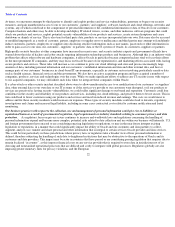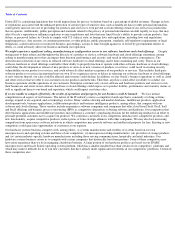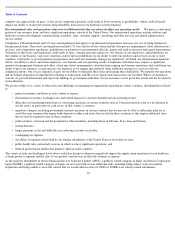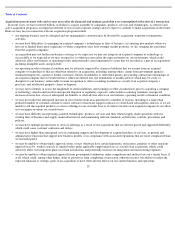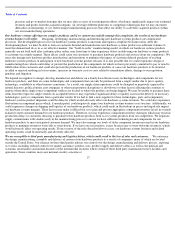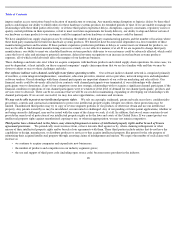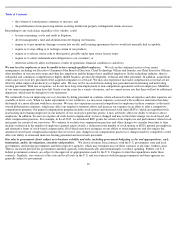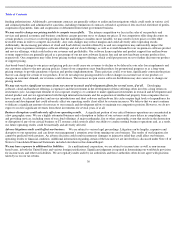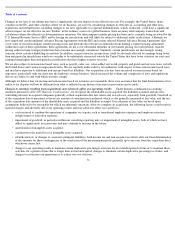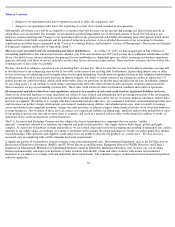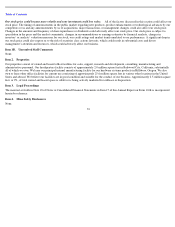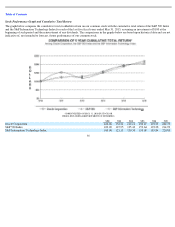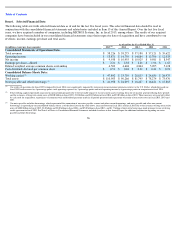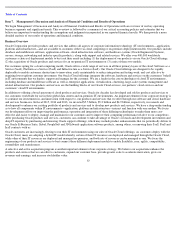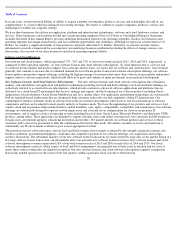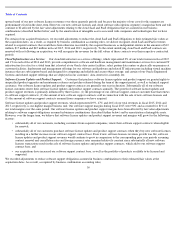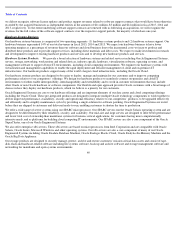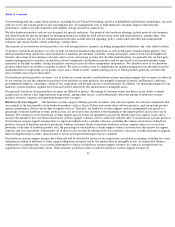Oracle 2014 Annual Report Download - page 35
Download and view the complete annual report
Please find page 35 of the 2014 Oracle annual report below. You can navigate through the pages in the report by either clicking on the pages listed below, or by using the keyword search tool below to find specific information within the annual report.
Table of Contents
Changes in tax laws or tax rulings may have a significantly adverse impact on our effective tax rate. For example, the United States, many
countries in the EU, and other countries where we do business, are actively considering changes in relevant tax, accounting and other laws,
regulations and interpretations, including changes to tax laws applicable to corporate multinationals, which, if enacted, could have a significant
adverse impact on our effective tax rate. Further, in the ordinary course of a global business, there are many intercompany transactions and
calculations where the ultimate tax determination is uncertain. Our intercompany transfer pricing has been and is currently being reviewed by the
U.S. Internal Revenue Service (IRS) and by foreign tax jurisdictions and will likely be subject to additional audits in the future. Although, we
have negotiated certain unilateral Advance Pricing Agreements with the IRS and certain selected bilateral Advance Pricing Agreements that
cover some of our intercompany transfer pricing issues and preclude the relevant tax authorities from making a transfer pricing adjustment
within the scope of these agreements, these agreements do not cover substantial elements of our transfer pricing. In recent periods, transfer
pricing audits in many foreign jurisdictions have become increasingly contentious. Similarly, certain jurisdictions are increasingly raising
concerns about certain withholding tax matters. In addition, our provision for income taxes could be adversely affected by earnings being lower
than anticipated in jurisdictions which we consider to be indefinitely reinvested outside the United States that have lower statutory tax rates and
earnings being higher than anticipated in jurisdictions that have higher statutory tax rates.
We are also subject to non-income based taxes, such as payroll, sales, use, value-
added, net worth, property and goods and services taxes, in both
the United States and various foreign jurisdictions. We are regularly under audit by tax authorities with respect to these non-income based taxes
and may have exposure to additional non-income based tax liabilities. Our acquisition activities have increased our non-income based tax
exposures, particularly with our entry into the hardware systems business, which increased the volume and complexity of laws and regulations
that we are subject to and with which we must comply.
Although we believe that our income and non-
income based tax estimates are reasonable, there is no assurance that the final determination of tax
audits or tax disputes will not be different from what is reflected in our historical income tax provisions and accruals.
Charges to earnings resulting from acquisitions may adversely affect our operating results. Under business combination accounting
standards pursuant to ASC 805, Business Combinations , we recognize the identifiable assets acquired, the liabilities assumed and any non-
controlling interests in acquired companies generally at their acquisition date fair values and, in each case, separately from goodwill. Goodwill as
of the acquisition date is measured as the excess amount of consideration transferred, which is also generally measured at fair value, and the net
of the acquisition date amounts of the identifiable assets acquired and the liabilities assumed. Our estimates of fair value are based upon
assumptions believed to be reasonable but which are inherently uncertain. After we complete an acquisition, the following factors could result in
material charges and adversely affect our operating results and may adversely affect our cash flows:
31
•
costs incurred to combine the operations of companies we acquire, such as transitional employee expenses and employee retention,
redeployment or relocation expenses;
•
impairment of goodwill, in particular within our consulting reporting unit, or impairment of intangible assets, both of which we have
added to significantly in recent years and may continue to increase in the future;
•
amortization of intangible assets acquired;
•
a reduction in the useful lives of intangible assets acquired;
•
identification of, or changes to, assumed contingent liabilities, both income tax and non-
income tax related, after our final determination
of the amounts for these contingencies or the conclusion of the measurement period (generally up to one year from the acquisition date),
whichever comes first;
•
charges to our operating results to maintain certain duplicative pre-merger activities for an extended period of time or to maintain these
activities for a period of time that is longer than we had anticipated, charges to eliminate certain duplicative pre-merger activities, and
charges to restructure our operations or to reduce our cost structure;



